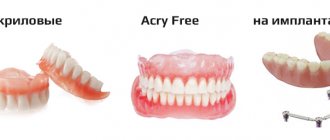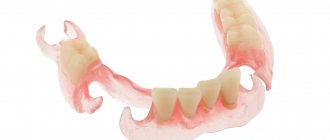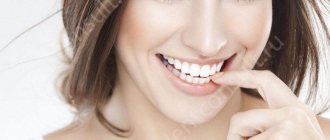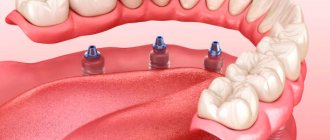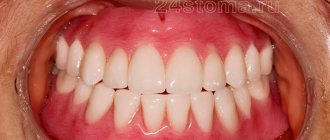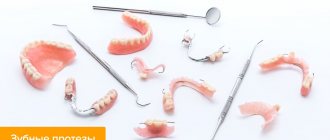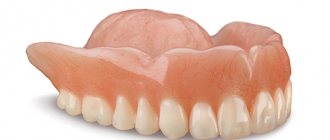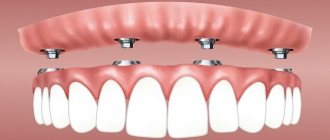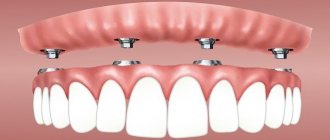- Work examples
- Questions and answers
- Stock
- Reviews
- Kinds
- Prices
Prosthetics of the upper jaw have a number of features compared to prosthetics of the lower jaw. Firstly, there are greater demands on aesthetics, since the upper jaw is more noticeable in the smile area, especially when it comes to the front teeth. Second, an upper denture can use the area of the palate for support and load distribution.
In general, a denture for the upper jaw, as well as for the lower jaw, can be removable or non-removable, complete or partial, used in the absence of a tooth or when it is destroyed. Modern dental technologies differ significantly in design, fixation methods, purposes and materials used.
How a partial denture is attached to the jaw
There are 3 options for fastening removable structures: hooks (clasps), locks (attachments), telescopic crowns.
We propose to consider each of the options in more detail. Clasps. They are hooks made of metal or plastic that grip healthy teeth and fix the orthopedic structure in the mouth. The disadvantage of such fastening is poor fixation and unsatisfactory aesthetics. Despite the fact that the hooks are covered by the lip, they are visible to others when smiling and talking.
Attachments. More preferable from an aesthetic point of view. The special lock consists of 2 parts. One element is built into the base of the prosthesis, and the other is attached to the crown that covers your own tooth. This fastening option has a more reliable fixation and gives the product stability. In addition, the attachments distribute the chewing load more evenly, which slows down bone atrophy by almost 2 times.
Telescopic crowns. Presented by a system consisting of 2 crowns.
The inner one follows the contours of the ground tooth. The outer one is connected to the base and restores the shape of the tooth. This allows the prosthesis to be securely fixed and prevents it from moving. The possibility of installing a telescopic structure in each specific case is determined by the doctor, since grinding of a large layer of hard tissue of the supporting tooth is required.
Clasp apparatus
Experts are confident that the only thing better than a removable structure for the upper or lower jaw is a fixed analog or clasp denture. The latter option is recommended for use in case of partial loss of teeth. It is based on a metal frame and is fixed on the supporting elements of the row.
It is distinguished by its compact size, which guarantees a high degree of comfort. The product rests on a thin metal arc. It is secured with clasps (hooks), attachments (micro-locks), and telescopic crowns. This model is more expensive, but its price is quite reasonable.
Indications and contraindications for use
Partial removable dentures are used in cases where the jaw is missing only a few teeth, but there are own healthy teeth that will be used as supporting teeth. Suitable for restoring both chewing and front teeth. The use of removable partial dentures is recommended in the following cases:
- missing several teeth;
- end defects of the jaw;
- atrophied bone tissue;
- the need for temporary prosthetics;
- contraindications to the installation of implants.
There are practically no contraindications to this type of prosthetics, and they are all temporary. These include viral diseases, carious lesions of teeth and periodontal tissue diseases.
Stages of manufacturing a removable partial denture
Depending on the type of prosthesis, the course of orthopedic treatment may differ slightly, but, in general, prosthetics can be divided into several main stages:
Preparation. After examination and diagnosis, the orthopedic doctor draws up a treatment plan and helps with choosing the optimal design option suitable for your particular case. At this stage, the oral cavity is sanitized. If necessary, teeth that cannot be saved are removed.
Taking impressions. Using impression material and a custom tray, the specialist takes impressions of the teeth on both jaws.
Manufacturing of the structure. In the dental laboratory, wax models are cast from the impressions, from which the technician makes the dentures.
Fitting and fixation. At the last visit, the doctor tries on the structure and fixes it in the oral cavity. If necessary, the prosthesis is adjusted and polished according to the bite.
Stock
-13%
Removable overdenture on 4 implants RUB 150,000.
130,000 rub.
get -6 %
BASAL COMPLEX - Restoration of teeth on 1 jaw in 3 days 265,000 rub.
250,000 rub.
get -40 %
Promotion for installation of veneers!
30000 rub. 18,000 rub.
get -19 %
German implants XIVE Friadent 80,000 rub.
65,000 rub. get
Lifespan of removable partial dentures
Practice shows that the service life of removable plate structures is on average 3-5 years, after which the structure has to be changed. Bugel products have a longer lifespan - up to 5-7 years.
In general, the duration of wearing depends on several factors:
— the quality of the design and the professionalism of the specialist who carried out the installation;
— characteristics of the body and the condition of the oral cavity, the presence of gum diseases and deformation of the dentition;
— accuracy of compliance with doctor’s recommendations and proper home care.
Rules for wearing and caring for prostheses
The first time after installation, removable dentures can cause discomfort. As a rule, it goes away by the end of the first week. In some cases, especially when using plate structures, addiction can last up to 3 weeks.
To speed up adaptation, there are general rules and recommendations: rinse your mouth with warm water more often, do not overload the denture with solid food for the first 3-4 days.
Carefully monitor hygiene, rinse your mouth after every meal, and beware of excessive chewing loads. For cleaning, you should not use abrasive cleaners; give preference to special solutions and pastes.
Are partial dentures repairable?
During use, individual parts of the prosthesis may break off. Under no circumstances should you attempt to repair it yourself; it is better to contact a specialist. If the situation can be corrected, it will only take a couple of days to fix it.
Every six months to a year, during a scheduled visit to the dentist, it is necessary to reline the plate and clasp structures, since the contour of the gums and the level of bone tissue change over time. The adjustment improves fit and load distribution, resulting in the product not chafing or breaking.
The most frequently asked questions about partial dentures
Is an allergy possible? How long does it take to get used to? Do you need fixing gels when wearing? You can find out the answers to these and other most popular questions in this section of the article.
— Is it possible to have an allergic reaction?
Is it possible. As a rule, an allergy can occur to acrylic when wearing plate dentures. Or on metal if wearing a clasp design. Before installing a prosthesis, a doctor may recommend that particularly sensitive people undergo a special test for sensitivity to materials.
— How long does it take to get used to it?
Sometimes it can take up to 3-4 weeks to get used to it. This usually applies to plate dentures, since they are more noticeable in the oral cavity. Clasp designs do not require so much time.
— Do I need to use fixing gels when wearing partial structures?
Partial structures do not require additional fixation, since they already have fastenings (hooks or clasps).
— Do I need to take off my dentures at night?
It is not at all necessary to remove the structure at night. It is not even recommended to remove the prosthesis for the first 3-4 weeks after installation, since there is an adaptation period. Further, at the discretion of the patient.
— Are there any restrictions when wearing?
Avoid eating excessively hard foods such as nuts or ice. It is also not recommended to eat foods that are too viscous and stick to artificial teeth.
Comments
What materials are such a prosthesis made of?
Makarova O.A. (08/21/2020 at 10:17 pm) Reply to comment
- The artificial base and gingival edge of the prosthesis are usually made of acrylic, but they are also made of nylon, silicone, polyurethane, and non-monomer acrylic resins. Fastening elements can be made from the base material that makes up the base of the prosthesis, but for strength and greater wear resistance they are often made from medical metal alloys. As for artificial teeth, they are made of plastic, metal-plastic, ceramic and metal-ceramic, and zirconium dioxide. That is, the choice is very wide and actually depends primarily on the type of prosthesis you choose (removable or implant-supported).
Editorial staff of the portal UltraSmile.ru (08/23/2020 at 12:21 pm) Reply to comment
Thanks for such a wonderful article. Tell me, what do you think, with very problematic and regularly inflamed gums, which option should you pay attention to first? The area for prosthetics is large, but I don’t want removable dentures.
Marina A. (09.23.2020 at 09:18) Reply to comment
Please tell me, my mother wants to install such a prosthesis, but I have heard that they are not reliable, they can fly out and wobble. In this case, there will be severe discomfort, is that true?
Elena (09/23/2020 at 01:01 pm) Reply to comment
And I heard that fixing dentures with cream, firstly, is not very reliable, and secondly, with prolonged use it can be dangerous. What creams should I use to ensure safety?
Victor (09/23/2020 at 01:07 pm) Reply to comment
If a removable denture was installed not so long ago, you are wondering how it is fixed, what is the covering structure? How much will it cost to fix removable covering systems on implants?
Oleg (09.23.2020 at 14:30) Reply to comment
Dentures were placed on the upper jaw. It took me a long time to get used to it, they pressed and rubbed. The gums were inflamed. I went many times for correction. Probably in a couple of months I began to wear them fully, but they began to fall off while eating. My dentist recommended Mostaden Twins Tech cream to me. It easily attaches to wet dentures. Does not change the taste of food and drinks. There is a pleasant mint taste in the mouth. Has a secure hold for up to 12 hours. Prevents food from penetrating under the denture. I began to fully wear the prosthesis without fear that it would fall out while eating or while talking.
Alice (10/21/2020 at 11:34 am) Reply to comment
Good afternoon Can you please tell me how long it will take to install dentures on my natural teeth? Is there any alternative while the prosthesis is being manufactured? Thanks in advance for your answer.
Sasha (11/20/2020 at 6:29 pm) Reply to comment
Of course, you can fix any prosthesis in your mouth. Both the lower and upper parts. But if you had surgery or had a bone cut off, then the prosthesis may not fit on such gums. Not every specialist will undertake such work.
Alina (11/20/2020 at 08:22 pm) Reply to comment
It’s good that now there are so many ways and options. But which one is the most reliable, which is recommended in most cases? Or will it all be purely individual?
Olga (11/20/2020 at 08:29 pm) Reply to comment
After reading the article, several questions arose. 1) How long do removable and fixed implants last? Which ones are more durable? 2) Is it difficult to care for them and maintain an aesthetic appearance?
Artyom (11/20/2020 at 09:04 pm) Reply to comment
Of course, implants are better because they will last better. And so my mother used Corega cream. Helped a little, but not much. She has the most ordinary prosthetics. Although I already made the second one 15 years later. The gums sank, so the first ones no longer held up.
Peter (11/20/2020 at 9:16 pm) Reply to comment
Write your comment Cancel reply
Partial dentures - reviews from specialists and patient opinions
In general, reviews of removable dentures from patients and doctors are positive. If there are contraindications to the installation of fixed structures, removable prosthetics are the only treatment option.
However, experts are confident that if there are no restrictions on implantation, the choice should be opted for prosthetics on implants. This option is the most preferable in terms of longevity, aesthetics, safety and prevention of bone atrophy.
Prices
| Service | Price |
| Removable acrylic (plate) dentures | from 15,200 rub. |
| Dental bridges | from 25,800 rub. |
| Nylon dentures | from 34,900 rub. |
| Clasp dentures | from 48,500 rub. |
| Dental prosthetics on implants | from 215,000 rub. |
| All-on-6 prosthetics | from 221,000 rub. |
To avoid possible misunderstandings, please clarify the cost of services in clinics with the administrator or during a consultation with a doctor. Prices on the website are not a public offer.
Sign up for a consultation
What is the cost of a partial denture?
First of all, the price varies depending on the type of prosthesis and the number of lost teeth. Many are sure that a high-quality prosthesis cannot be very cheap. So what does its cost consist of?
The material of construction plays a big role in pricing. Modern dental clinics work with proven compounds for the manufacture of structures. This guarantees the quality, aesthetics and durability of the product.
All designs are made individually, based on the characteristics of the jaw structure, patient preferences and doctor’s recommendations.
Professionalism of staff and technical equipment. The experience of an orthopedist and dental technician, as well as high-tech equipment, is very important, so the price tag also adds up in terms of costs.
Types of removable dentures in complete absence of teeth
The base of complete dentures (artificial gum) can be made of different materials
Where in Voronezh can a partial removable denture be installed?
For a quality result, it is important to choose a dental clinic and attending physician wisely. Making the wrong choice can create a lot of problems and cost you a lot of time and money to fix the mistake. Be sure to pay attention to the specialist’s experience, the availability of modern equipment and reviews of other patients.
You can install partial removable dentures in Voronezh at. We offer production using modern equipment, high-quality materials and competitive prices. Our consummate specialists are always ready to help. We are waiting for you for your first free consultation!
